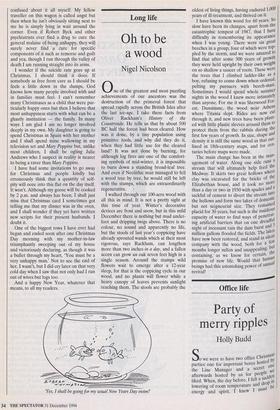Long life
Oh to be
a wood
Nigel Nicolson
One of the greatest and most puzzling achievements of our ancestors was the destruction of the primeval forest that spread rapidly across the British Isles after the last ice-age. I take these facts from Oliver Rackham's History of the Countryside. He tells us that by about 500 BC half the forest had been cleared. How was it done, by a tiny population using primitive tools, and why did they do it, when they had little use for the cleared land? It was not done by burning, for although log fires are one of the comfort- ing symbols of mid-winter, it is impossible to burn down a standing broad-leaf tree. And even if Neolithic man managed to fell a wood tree by tree, he would still be left with the stumps, which are extraordinarily regenerative. • I walked through our 100-acre wood with all this in mind. It is not a pretty sight at this time of year. Winter's decorative devices are frost and snow, but in this mild December there is nothing but mud under- foot and dripping twigs above. There is no colour, no sound and apparently no life, but the stools of last year's coppicing have already sprouted wands which at their most vigorous, says Rackham, can lengthen more than two inches in a day, and a fallen acorn can grow an oak seven feet high in a single season. Around the stumps wild flowers wait to emerge after a 12-year sleep, for that is the coppicing cycle in our wood, and no plants will flower while a heavy canopy of leaves prevents sunlight reaching them. The stools are probably the 'Yes, I shall be going for my usual New Years Day swim? oldest of living things, having endured 1,000 years of ill-treatment, and thrived on it. I have known this wood for 60 years. So slow have been its changes, apart from the catastrophic tempest of 1987, that I have difficulty in remembering its appearance when I was young. There were six great beeches in a group, four of which were top- pled by the storm, and we were amazed to find that after some 300 years of growth they were held upright by their own weight on so shallow a saucer of roots. These were the trees that I climbed ladder-like as a boy, refusing to come down when ordered, pelting my pursuers with beech-mast. Sometimes I would spend whole summer nights in the wood I knew more intimately than anyone. For me it was Sherwood For- est, Dunsinane, the wood near Athens where Titania slept. Rides are now cut through it, and new trees have been plant- ed with little plastic sleeves around them to protect them from the rabbits during the first few years of growth. In size, shape and density it is still the same wood as that out- lined in 18th-century maps, and for cen- turies before maps were made. The main change has been in the man- agement of water. Along one side runs a stream that will ultimately help feed the Medway. It skirts two great hollows where clay was excavated for the bricks of the Elizabethan house, and it took no more than a day or two in 1930 with spades and a sackful of cement to divert the stream into the hollows and form two lakes of domestic but not seigneurial size. They remained placid for 30 years, but such is the insidious capacity of water to find ways of penetrat: ing artificial barriers that on one dreadfln night of incessant rain the dam burst and 3 million gallons flooded the fields. The lakes have now been restored, and stand in silent company with the wood, both for a few months longer sullen and unappealing, but containing, as we know for certain, the promise of new life. Would that human. beings had this astonishing power of annual revival!


























































 Previous page
Previous page